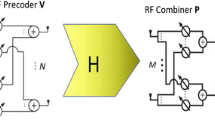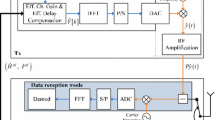Abstract
Analog–digital combining is an alternative solution to decrease the hardware complexity of an all-digital combining system. We analyze the analog weights from the perspectives of maximizing analog signal-to-noise ratio (SNR) and effective channel capacity \({(\tilde{C})}\). We propose simple sub-optimal algorithms to calculate receive analog weights in both open loop (OL) and closed loop (CL) systems, and compare the proposed schemes with an all-digital combining system, in terms of \({\tilde{C}}\). For both criteria, a small number of additional antennas is required to achieve the same mean capacity as an all-digital combining system in an urban micro model, e.g., 1 additional antenna in selection diversity and combining is required to achieve the same capacity as in a 2 × 4 all-digital CL system at low SNR. The additional number of antennas is smaller in CL than in OL. The effective channel capacity based on the SNR maximization criterion is similar to that based on the \({\tilde{C}}\) maximization criterion, but the computational complexity the analog weights calculation is lower for the SNR maximization criterion.
Similar content being viewed by others
References
Winters J. H. (1987) On the capacity of radio communication systems with diversity in a Rayleigh fading environment. IEEE Journal on Selected Areas in Communications 5(5): 871–878
Foschini G. J., Gans M. J. (1998) On limits of wireless communications in a fading environment when using ultiple antennas. Wireless Personal Communications 6(3): 311–335
Sandhu, S., & Ho, M. (2003). Analog combining of multiple receive antennas with OFDM. IEEE international conference on communications (Vol. 5, pp. 3428–3432).
Donovan, D. (2007). Managing cost issues in femtocell home base station design. Part 1. RF Design Line, http://www.rfdesignline.com/howto/201806254. Document accessed: Feb 2009.
Analog-to-digital converter ICs, In: Analog Devices Solutions Bulletins, Vol. 7, Issue no. 3, http://www.analog.com/static/imported-files/solutions_bulletins/SB_V7ADC_4-07.pdf. Document accessed Feb. 2009.
Arnold, H. (2008). SiGe semiconductor: RF front-ends enable wireless multimedia. EE Times Europe, http://eetimes.eu/showArticle.jhtml?articleID=206100348. Document accessed: Feb 2009.
Heath, R. W. Jr., Sandhu, S., & Paulraj, A. (2001). Antenna selection for spatial multiplexing systems based on minimum error rate. Proceedings of IEEE international control conference (Vol. 7, pp. 2276–2280).
Molisch A. F., Win M. Z., Choi Y. -S., Winters J. H. (2005) Capacity of MIMO systems with antenna selection. IEEE Transaction on Wireless Commununication 4(4): 1759–1772
Bölcskei, H., Gesbert, D., Papadias C. B., & van der Veen, A.-J. (Eds.). (2006) Beamforming techniques. In space-time wireless systems: From array processing to MIMO communications (pp. 23–43). Cambridge: Cambridge Press.
Brunner, C., Hammerschmidt, J. S., Seeger, A., & Nossek, J. A. (2000). Space-time eigenrake and downlink eigenbeamformer: Exploiting long-term and short-term channel properties in WCDMA. Proceedings of IEEE global telecommunication on conference, San Francisco, CA (Vol. 1, pp. 138–142).
Paulraj A., Nabar R., Gore D. (2003) Introduction to space-time wireless communications. Cambridge University Press, Cambridge
Monzingo R. A., Miller T. W. (1980) Introduction to adaptive arrays. Wiley, London
Strang G. (2003) Introduction to linear algebra. Wellesley Cambridge, Wellesley
Villard, G. (2001–2002). Compuatation of the inverse and determinant of a matrix. Algorithms Project’s Seminar, 29–32.
Salo, J., Galdo, G. D., Salmi, J., Kyösti, P., Milojevic, P., Laselva, D., & Schneider, C. (2005). MATLAB implementation of the 3GPP spatial channel model (3GPP TR 25.996), On-line, http://www.tkk.fi/Units/Radio/scm/.
Author information
Authors and Affiliations
Corresponding author
Rights and permissions
About this article
Cite this article
Zhou, X., Winters, J.H., Eggers, P.C.F. et al. Capacity and Complexity Trade-offs in MIMO Analog–Digital Combining Systems. Wireless Pers Commun 54, 685–698 (2010). https://doi.org/10.1007/s11277-009-9775-3
Received:
Accepted:
Published:
Issue Date:
DOI: https://doi.org/10.1007/s11277-009-9775-3




